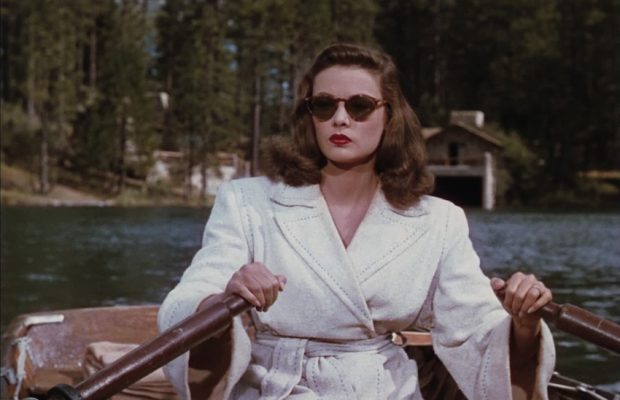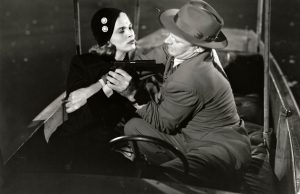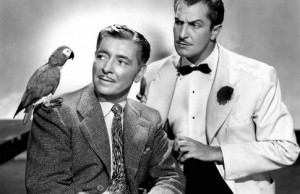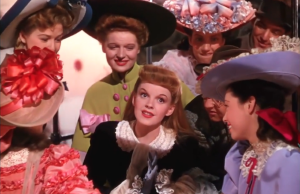Leave Her to Heaven (1945)

Toronto Film Society presented Leave Her to Heaven (1945) on Monday, August 14, 2017 in a double bill with Dressed to Kill as part of the Season 70 Summer Series, Programme 5.
Production Company: 20th Century Fox. Producer: William A. Bacher. Director: John M. Stahl. Screenplay: Jo Swerling, based on the novel by Ben Ames Williams. Music: Alfred Newman. Orchestrations: Edward Powell. Photography: Leon Shamroy. Film Editor: Harry Gerstad. Art Directors: Lyle Wheeler, Maurice Ransford. Editor: James B. Clark. Special Effects: Fred Sersen.
Cast: Gene Tierney (Ellen Berent), Cornel Wilde (Richard Harland), Jeanne Crain (Ruth Berent), Vincent Price (Russell Quinton), Mary Phillips (Mrs. Berent), Ray Collins (Glen Robie), Gene Lockhart (Dr. Saunders), Reed Hadley (Dr. Mason), Darryl Hickman (Danny Harland), Chill Wills (Leick Thorne), Paul Everton (Judge), Olive Blakeney (Mrs. Robie), Addison Richards (Bedford), Harry Depp (Catterson), Grant Mitchell (Carlson), Milton Parsons (Medcraft), Betty Hannon (Tess Robie), Mae Marsh (Fisherwoman), Earl Schenck (Norton), Hugh Maguire (Lin Robie), Kay Riley (Nurse).
Reviewing Leave Her to Heaven for Time magazine, James Agee complained about the dissonance of using colour for a noir film saying that the story’s central idea might be plausible enough in a dramatically lighted black and white picture but not in the rich glare of Technicolor. For Agee, Technicolor sets the wrong mood, evoking thoughts and emotions antipathetic to the film’s premise. Yet Leave Her to Heaven became Fox’s highest-grossing picture of the decade and remains of interest to critics in part because of its incongruous mixture of melodrama stylistics and noir subject matter. Technicolor is not an outlandish choice, but it is an improbable one and, given audiences’ psychological associations with the format, one that requires some mental adjustment.
Other stylistic choices also work against the film’s morbid story, including Alfred Newman’s melodramatic score; the casting of Cornel Wilde, known in 1945 mostly for his romantic melodramas and swashbucklers, as the protagonist, Richard; and overdramatic dialogue delivered in breathy voices, the actors looking off into the distance. Sometimes it seems as though different filmmakers are battling over the film’s genre, style, and tone. Lines that begin sentimentally sometimes turn menacing. Leave Her to Heaven remains interesting, and offers an odd footnote in histories of American crime films of the period, because its style, alternately melodramatic and sinister, sometimes works against its genre identity.
In Gene Tierney’s autobiography, she talks about how she had been at a cocktail party in Romanoff’s when Zanuck told her he was thinking of giving her the part of Ellen. She was thrilled when he called her to say she had gotten the part and felt that the director John Stahl, who had a reputation for bringing out the best in an actress, would do well by her. However, he was also a taskmaster and one Saturday night he asked her to stay behind to run through the rowboat scene so that the cameraman could work out the lighting. When she finished her lines, Stahl was silent, then groaned, “That was perfect, just the way it should be done. But you will never get it again, not in a million years.” She calmly told him that she would as that’s how she had been rehearsing it. He didn’t acknowledge this, restating that it would never come to be, but in the end she surprised him by repeating the scene exactly the way she had done it on the Saturday evening.
In her seduction scene of Cornel Wilde, Tierney recalled that Cornel had a hard time with the roles being reversed and after each take, the gaffers on the crew would whistle their approval of Gene. Impatiently, Stahl waved his hand at the crew, turned to Wilde and said, “They all seem to understand how the scene should be played, why can’t you?!”
When Philip K. Scheuer asked Gene Tierney how she felt while she was playing the villainous Ellen. “Mentally unbalanced,” she flashed, “I’m naturally a happy person, but such parts are fascinating. In a world of sick human beings, it’s a full-time job trying to get inside these people to find out what makes them the way they are.”
Her performance in Leave Her to Heaven brought Gene her only nomination for an Academy Award. With her husband Oleg Cassini, who was sure his wife was going to win, they waited in the audience that night for what seemed forever. But when the audience applauded for the film clip of Joan Crawford in Mildred Pierce, Tierney knew she had lost. Still, she was comforted by her new confidence that she did a good job in a difficult role and felt honoured by the praise personally given to her by David Selznick and Jennifer Jones. However, the most sincere compliment she said she received was from the black cook of friends of hers in Cape Cod. When this lady, who had seen the film, heard that Gene was going to be visiting, she threatened to leave, fearing that the actress was really like her character. But after chatting for a bit, the cook smiled and said, “You sure were mean in that picture. Now that I’ve seen you, you are real nice.”
Sourced from Into the Dark: The Hidden World of Film Noir 1941-1950 by Mark A. Vieira (2016), Hollywood Aesthetic: Pleasure in American Cinema by Todd Berliner (2017) and Self-Portrait by Gene Tierney with Mickey Herskowitz (1979)
Introduction by Caren Feldman
“The seamier side of the ladies is receiving a great deal of publicity in Leave Her to Heaven. What makes it particularly impressive is that Ben Ames Williams’s heartless heroine is portrayed by the beauteous Gene Tierney, who aids and is aided by Technicolor. She is really something to look at, especially until she smiles, and in some of the early shots the camera knows what it’s got when it lingers long on her eyes.
Since Leave Her to Heaven comes right out with its revelation, there’s no reason for this review to withhold valuable information. Jealousy is the deadliest of the sins. This may seem far-fetched to you, but that only means you haven’t sampled the brand of jealousy Tierney projects. It isn’t merely annoying. It doesn’t stop with divorce and the courts. It goes in for refinements of murder. So that Leave Her to Heaven shares the attractions of horror blooming in the midst of tranquility as well as the more familiar melodrama of the murder trial.
Miss Tierney’s enameled beauty lifts from her shoulders the burdensome necessity of powerful acting. Her romantic thrill, Cornel Wilde, keeps or is kept within sufficiently narrow limits to avoid contrasts. Her adopted sister, Jeanne Crain, does well as a sweet young thing. Only Vincent Price is permitted luxury of the bravura in his prosecuting attorney role. Maybe they couldn’t stop him; he does give an impression of irresistible actor’s momentum.
The value of Leave Her to Heaven lies in its beautiful photography, both of person and scene, and in its comparatively bold attempt to widen the range of human nature as seen in the movies. A few more like this and men will think twice before letting a gorgeous dame overwhelm them into matrimony. The weakness of the film is that it gives the impression of characters carved to fit a sensational plot rather than a story flowing inevitably out of the people themselves. It’s flashy entertainment, after the slow start.” – Archer Winsten, The New York Post, December 26, 1945
“The most pretentious and certainly the most expensive of the Christmas film offerings is Leave Her to Heaven, a Sophoclean story in a modern House & Garden setting, in which an insanely possessive woman wreaks tragedy on herself and on all around her, in a vain effort to monopolize a man. The film is a virtually unrivalled example of how magnificently Hollywood can squander an idea. The settings; the costuming; the limpidness and grandeur of exteriors in exquisite Technicolor; and the expensive good taste of the interiors—all these are almost ideally conceived. But the same standards, those of physical perfection, fail rather dismally when applied to the human elements of the story. Probability is lost rapidly in the hands of Tierney and Wilde, however indisputably they fit the photogenic requirements.
In accepting the principal roles, Tierney and Wilde bit off much more than they could chew in the way of dramatics. In addition, the script burdens them with some of the most freighted of nonsense for dialogue, so that it seems as if the two handsome leads were spending most of their time dotting i’s, crossing t’s, and making sure of pronunciations instead of getting inside a character and living it.” – John T. McManus, PM, December 26, 1945
“Director Stahl has certainly made the most out of the book and done well directing the young players. The picture is made of the stuff that women go for—love, hate, and sex.” – Wanda Hale, Daily News, December 26, 1945
Film notes originally written for TFS’s Summer Series screening on Monday, August 14, 1978














Leave a Reply